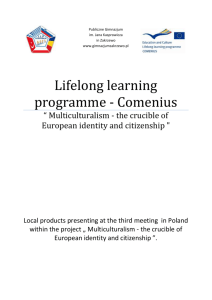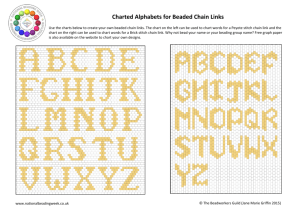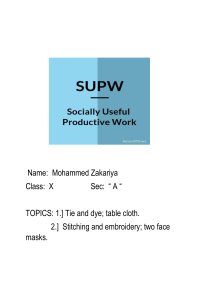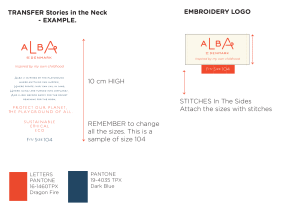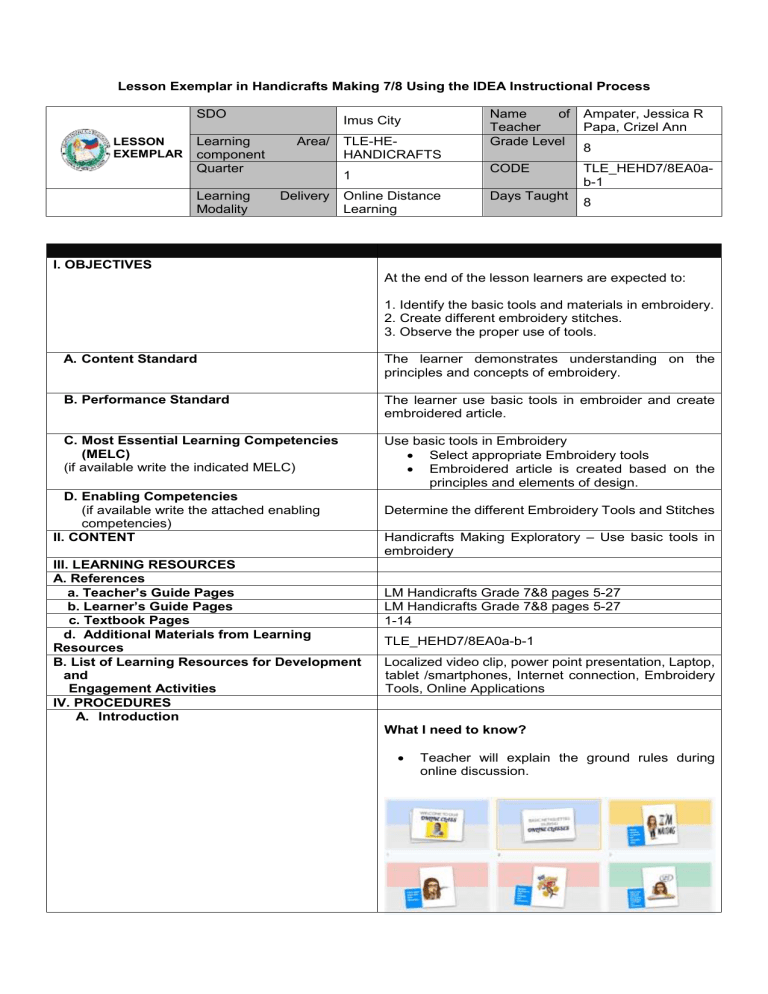
Lesson Exemplar in Handicrafts Making 7/8 Using the IDEA Instructional Process SDO LESSON EXEMPLAR Learning component Quarter Learning Modality Imus City Area/ TLE-HEHANDICRAFTS Name of Ampater, Jessica R Teacher Papa, Crizel Ann Grade Level 8 CODE 1 Delivery Online Distance Learning Days Taught TLE_HEHD7/8EA0ab-1 8 I. OBJECTIVES At the end of the lesson learners are expected to: 1. Identify the basic tools and materials in embroidery. 2. Create different embroidery stitches. 3. Observe the proper use of tools. A. Content Standard The learner demonstrates understanding on the principles and concepts of embroidery. B. Performance Standard The learner use basic tools in embroider and create embroidered article. C. Most Essential Learning Competencies (MELC) (if available write the indicated MELC) Use basic tools in Embroidery Select appropriate Embroidery tools Embroidered article is created based on the principles and elements of design. D. Enabling Competencies (if available write the attached enabling competencies) II. CONTENT III. LEARNING RESOURCES A. References a. Teacher’s Guide Pages b. Learner’s Guide Pages c. Textbook Pages d. Additional Materials from Learning Resources B. List of Learning Resources for Development and Engagement Activities IV. PROCEDURES A. Introduction Determine the different Embroidery Tools and Stitches Handicrafts Making Exploratory – Use basic tools in embroidery LM Handicrafts Grade 7&8 pages 5-27 LM Handicrafts Grade 7&8 pages 5-27 1-14 TLE_HEHD7/8EA0a-b-1 Localized video clip, power point presentation, Laptop, tablet /smartphones, Internet connection, Embroidery Tools, Online Applications What I need to know? Teacher will explain the ground rules during online discussion. BASIC NETIQUETTES DURING ONLINE CLASS 1. Please show up on time at the schedule time. 2. Find a quiet place, free from distraction. 3. Maintain RESPECT in both speaking, and appearance. 4. Stay on mute. Please use chat box if you would like to contribute or have any clarifications. 5. Video needs to remain ON to promote focus. Eye contact should be maintained 6. Refrain from chewing gum and eating in front of the camera Learners will have a walkthrough on the lesson outcomes of the course. The module covers 3 lessons that a Grade 8 Technology and Livelihood Education (TLE) student like you ought to understand. As shown below, each Lesson is directed to the attainment of one or two learning outcomes: Lesson 1 –Produce embroidered article LO1. Use basic tools in embroidery. LO2. Create embroidered article Lesson 2 – Produce recycled project LO1. Understand recycling. LO2. Create recycled project Lesson 3 – Produce wrapped gift items LO1. Wrap gift items Your success in this exploratory course on Handicraft is shown in your ability to perform the performance standards found in each learning outcome What’s New? Learners will play a fact and bluff game about the Development of Embroidery in the Philippines. Socrative application will be used for the activity. Teacher will present the Score Analysis. B. Development What I know? Learners will answer the given 15-item pretest using google forms. What’s in? Teacher will present a localized video about Embroidery Tools and give tips on proper usage of it. Video link: (6) BASIC EMBROIDERY TOOLS - YouTube What is it? C. Engagement Teacher will show the different embroidery tools and materials and will encourage the learners to identify and explain the proper way on how to use it. What’s More? Teacher will present the localized video on the different Embroidery Stitches. EMBROIDERY STITCHES Back stitch- the most often used to outline a design. This stitch also forms the base line for other embroidery stitches Bullion stitch- a single detached stitch that is used for filling in a design area. Rows of bullion stitches may also be used to outline a design. It is recommended that one uses a needle with a small eye for ease in pulling Chain stitch- one of the more popular stitches used for outlining. When worked in close rows, chain stitches make good stitches for filling the design area. Cross-stitch- stitched formed by two crossing arms and may be used for outlining, as borders or to fill in an entire area. Feather stitch- a stitch with a loop and stitches evenly worked on both left and right sides of a design area. Fish Bone- a kind of filling stitch which is ideal for making leaves or feathers. It requires us to divide the pattern into two and each side is filled alternately giving it a plaited effect in the centre, thus ideal to make leaves or feathers. French knot- a single detached stitched used primarily to fill in a design area. It is a popular stitch among embroiderers in that it can be used to create the eyes on an embroidered face or the center of a flower. Herringbone stitch- a basic overlapping stitch popular for its use in borders. Lazy daisy chain stitch- also called detached chain stitch, this stitch is work in a circle to resemble the petals of a flower. Looped stitch- a very decorative stitch and can be experimented with threads for various colors over borders. Close layers of this stitch can create wonderful effects on a pattern. Running stitch- considered being the easiest stitch for outlining. 12. Satin stitch- a solid filling stitch that is used to cover a design area with long, straight stitches worked very close together Split- done using quite thick threads, such as wool. It was used as an outlining stitch or as a filling stitch. Seed- also known as rice grain stitch. Stitch uses simple straight stitches in a single direction to fill in patterns. It has shorter stitches above the fabric and longer stitches on the reverse side. They remind of strawberry seeds, probably, which inspired its name. Stem Stitch- basically an outline stitch, this stitch is usually used for flower stems, and outlines. It can only be used as filling, rows of Stem stitch worked closely together within a shape until it is filled completely. Present another videos on doing Embroidery Stitches. https://www.embroidery.rocksea.org/stitch/ What I can do? Let the learners show their actual embroidery tools available at their home. Example: What else I can do? Learners will create a simple project that shows the different embroidery stitches. Example Rubrics D. Assimilation What I have learned? The learners will play a game named “Pass the MICROPHONE” The teacher will explain the mechanics and pointing system of the game. What I can do? (Assessment) V. REFLECTION Using Quizziz application, learners will answer the 10-item quiz to check their understanding about Embroidery Tools and Materials. Learners will answer the given attendance form to share their insights and thoughts in our lesson today. This will serve as their attendance also.

